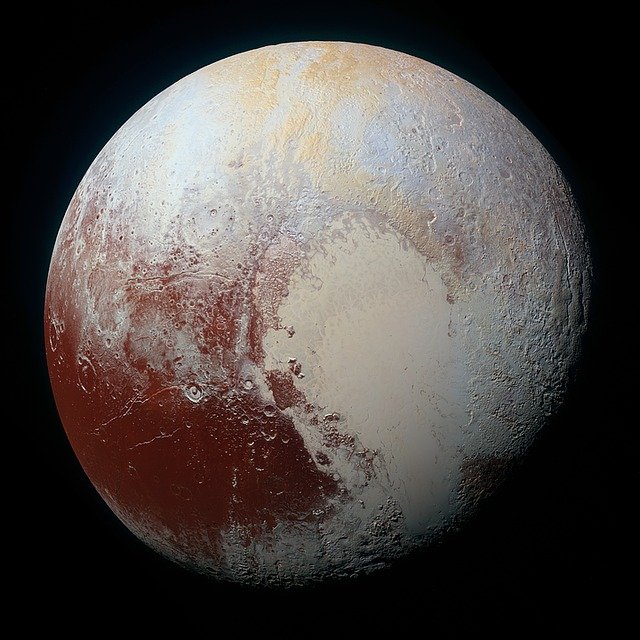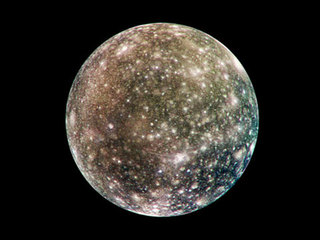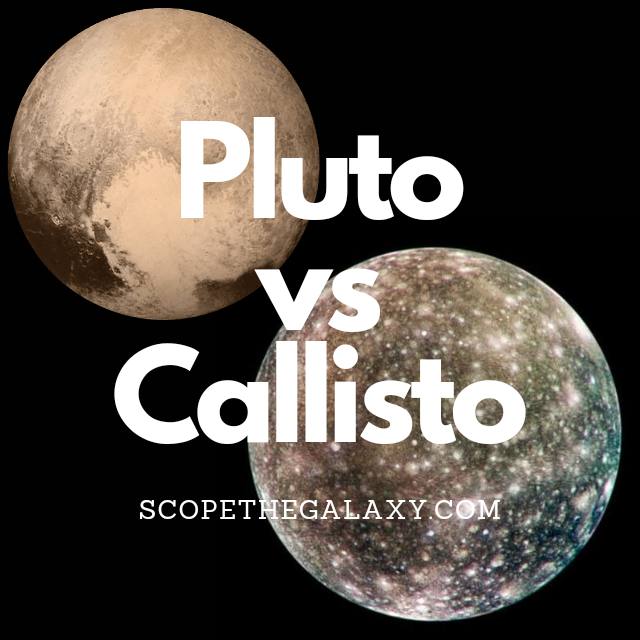*This post may contain affiliate links. This means we may make a commission if you purchase an item using one of our links*
The main differences between Pluto and Callisto would be that Pluto is a dwarf planet with 5 moons that orbit it whilst Callisto is the 3rd largest moon in the solar system that also orbits Jupiter, Pluto is far smaller than Callisto with a diameter of 2,370km whilst Callisto’s is 4,820.6km which also makes the latter the heavier of the two.
There are various other differences between the two so, continue reading for a more detailed look at each celestial body along with a more in-depth look at their similarities and differences.
What Is The Planet Pluto?
Table of Contents

In the past Pluto was the 9th farthest official planet in our solar system however, in 2006 after many debates between astronomers, the International Astronomical Union officially downgraded it to a dwarf planet.
The reason for this downgrade at the time was primarily down to Pluto simply being very small when compared to every other planet and even the moons orbiting these planets. Pluto’s dwarf status is debated still to this day but, for now it still remains under this dwarf bracket for a planet
Its diameter for example is only 2,370km, which is a third of Earth’s Moon. With that being said, despite the significant size discrepancy Pluto shows, it still does have more moon like objects orbiting it than Earth and I’m not saying just one more.
In total this terrestrial dwarf planet has 5.
Pluto’s atmosphere consists mostly of molecular nitrogen whilst molecules of methane and carbon monoxide have been observed also. As for its surface, it consist mostly of frozen nitrogen, methane, and carbon monoxide ices.
One of Pluto’s most unique characteristic is that Charon (its largest moon) is tidally locked to it and vice versa, which means that the two essentially orbit each other.
In essence only one side of Charon and one side of Pluto surface will face each other at any given time.
Pluto’s temperature is between -222 to -232 degrees Celsius based on how close it gets to the Sun when orbiting it, whilst its core temperature isn’t anything too special sitting around 500 – 1,000 degrees Celsius.
The main reason it’s as cold as it is and has a relatively cold core in comparison to the other planets would be, which is mostly down to its size. A larger size would mean more mass could be compressed at the center which would produce more heat at the core.
Pluto’s orbit is also different from the other main plants in our solar system, following an elliptical orbital path as opposed to the circular path the others take. As a result of its distance from the Sun, Pluto will complete each one of these elliptical cycles around once every 247.78 years.
Even its rotational cycle is very slow, where one cycle is completed in 157 hours. Another interesting fact is the Pluto’s axial tilt is almost on its side at 57 degrees, similar to Uranus.
What Is The Moon Callisto?

Callisto is one of the large moons orbiting Jupiter, the outermost of the Galilean moons, first discovered on 7th January 1610. The surface of this icy world is frozen, but scientists believe an underground ocean could reside beneath the ice.
Even if there’s water on Callisto, it won’t necessarily hold life because the surface is so old. Scientists will need to conduct more research into the moon before determining whether this is a likely possibility.
The ESA’s JUICE (Jupiter Icy Moon Explorer) mission is focused on the three ice moons of Jupiter. It is expected to arrive in 2030 and will focus on learning more about the environment of each, as well as their potential for hosting life.
Scientists estimate that Callisto is around 4.5 billion years old (the same age as Jupiter), and its average distance from the Sun is approximately 778 million km. It has a diameter of 4820.6km, which makes it similar in size to the planet Mercury, and the average temperature is a frigid minus 139.2 degrees Celsius.
Callisto takes seven days to orbit its planet at an average distance of 1,880,000km, and it is tidally locked, meaning the same side of it always faces Jupiter. But this moon experiences less tidal influence than the other Galilean moons because it lies in the orbit of Jupiter’s primary radiation belt.
The name of this moon is derived from the stories of Greek myth. Callisto was the nymph who had an affair with Zeus, the King of the Gods. Upon hearing this news, Zeus’ wife Hera turned Callisto into a star and placed her in the Ursa Major constellation. Interestingly, every moon of Jupiter is named after a Greek figure who Zeus seduced.
Callisto may be the third biggest moon and similar in size to the planet Mercury, but it only has a mass of 107,593,737,963.819 billion kg. That may sound like a lot, but it’s only ⅓ the mass of the similarly sized Mercury.
You may wonder why scientists classify Callisto as a “moon” rather than a planet if it’s almost the same size as Mercury. The reason is simple; planets must orbit the sun, but Callisto orbits one of the planets.
The composition of this frigid world is around 60% rock and iron and 40% ice. The moon has roughly equal amounts of rock and ice, plus the potential for water below the surface. There are also traces of carbon dioxide, organic compounds, and silicates.
This moon is one of the oldest landscapes in the Milky way and the most heavily cratered body in our system. However, scientists believe this could now be a “dead” moon as there are no longer any signs of volcanism or plate tectonics on its surface.
Similarities Between Pluto And Callisto
Callisto and Pluto do have their fair share of similarities, which in this case would include the following:
- Both have a hotter central core.
- Both are a spherical in shape.
- Both are terrestrial planets.
- Both have a very thin atmosphere and a rocky surface.
- Neither have tectonic plates.
- Both elliptically orbit their celestial objects.
Differences Between Pluto And Callisto
In regards to the differences, they would be the following:
- Callisto is the bigger of the two as it has a diameter of 4,820.6km compared to Pluto’s 2,370km.
- Pluto has 5 moons whilst Callisto has 0.
- Pluto is a dwarf planet whilst Callisto is a natural satellite.
- Pluto orbits the Sun whilst Callisto orbits Jupiter and the Sun.
- It takes Pluto 247.78 years to complete a full orbit around the Sun whilst Callisto completes it in 12 years.
- A day on Pluto takes 157 hours whilst a day on Callisto is 17 days.
- Pluto has an axial tilt of 57 degrees compared to Callisto’s that is practically 0.
- Callisto’s average temperature is -139.2 degrees whilst Pluto’s average ranges between -222 and -232 degrees Celsius.
- Callisto’s atmosphere is composed of a very thin carbon dioxide based exosphere whilst Pluto’s atmosphere is composed of 90% nitrogen and 10% methane, carbon monoxide among other complex molecules.
- Callisto’s gravity is 1.236 m/s² compared to Pluto’s that is 0.62 m/s².
- Pluto’s mass is 1.309 x 10^22 whilst Callisto’s mass is 1.07 x 10^23 kg.
- In regards to density, Pluto’s is 1.88 g/cm³ whilst Callisto’s is 1.83 g/cm³
Summary
Both Pluto and Callisto do have their fair share of similarities from their elliptical orbital pattern, their low density bodies and terrestrial composition.
With that being said there a lot of differences between the two as well such as their size, mass, the length of their days, the length of there orbital cycle and beyond.

